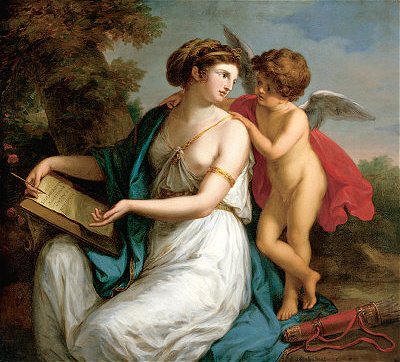She was very influenced by Johann Winkelmann, who lived in Rome. He invented "History of Art". Although he was not a painter, he influenced her style to be neo classical. This is very Grecian, curly hair, rather soft feminine forms (even the men e.g. "David"). In 1767 she married a phony Count, but that marriage did not last long and was later annulled. In 1776, at age 35, she went to London. There she received many commissions for portraits. She often turned them into historical paintings, with the faces of her customers. In England she also did a lot of printmaking. That was the rage there at that time. She also did pencil drawings, porcelain, painted ceilings, furniture and cloisonn . She spent a total of 15 years in England. She is a friend (lover?) of Joshua Reynolds and one of the founders of the Royal Academy of Art. In her life she had many love affairs. Names associated with her are Benjamin West, Dance (she was engaged to him), Hamilton, Winkelmann, Jean Meurat and Reynolds. She did not have any children. In 1781 (age 40) she married Antonio Zucchi. A year later she sets up a studio in Rome, but then her husband dies in that same year. In 1797 (age 56) she had a show in the Royal Academy of Art in London. In 1807 (age 66) she dies in Rome. Our Museum Painting: Sappho Painting dates from 1774. In 1775 it was presented in the Royal Academy of Art. This is the time after her marriage was annulled. She was very depressed then. She paints herself as Sappho. Sappho was a female Homer with beautiful poetry. Although married with children, her poems show that she loved women. She lived on the Island Lesbos and hence the name "lesbian" for a female homosexual. The painting is in neo classical style. The light is diffused, no harsh lines, even on the arrows or elbow, where you would expect them. Even the reds are subdued. She also uses open brushwork in the drapes and clothing. The face is not photographic. It is very soft. The poem on the scroll is to Aphrodite. Her son Eros is next to her. There are 2 translations for the text on the parchment:
|
